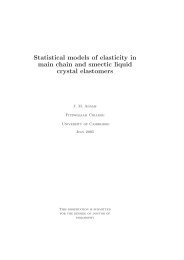Zephyr: A High Altitude Long Endurance Unmanned Air Vehicle ...
Zephyr: A High Altitude Long Endurance Unmanned Air Vehicle ...
Zephyr: A High Altitude Long Endurance Unmanned Air Vehicle ...
- No tags were found...
You also want an ePaper? Increase the reach of your titles
YUMPU automatically turns print PDFs into web optimized ePapers that Google loves.
Chapter 2Technical Data2.1 StructureAs the aircraft operates using solar power, it needs to be as light as possible in orderto reduce the power needed to fly it, while still remaining strong and supporting theother components. The airframe structure is span loaded, meaning the weight isdistributed along the wings, and thus the wings are very large to support the weight.Each section of the wing supports itself and a bit more, so <strong>Zephyr</strong> must be carefullysupported when sitting on the ground. If it was picked up by the fuselage, the wingswould snap off. This is because the wings are designed to withstand upwards pressurefrom the air when in flight, and not the downward pull from gravity. Mostplanes/UAV’s aren’t like this and can sit on their point-loaded undercarriage. It ismade of ultra light carbon fibre and designed to carry a distributed avionics and powersystem.2.2 PowerOne of the most critical parts of the UAV are the batteries and the solar cells whichpower the plane. During the day an amorphous silicon (a-Si) solar array is used togenerate all the power needed to fly the aircraft at its maximum altitude, as well asfully recharge the batteries for the night flight. Amorphous silicon solar cells areknown as ‘thin film’ silicon cells as they use layers of a-Si only a few micrometersthick. As these cells are so thin, they use less than 1% of the silicon used in standard16
















